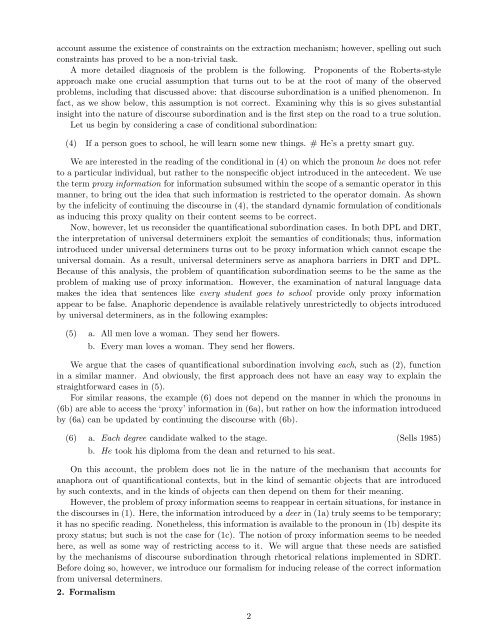SemPrag03.Progr.pdf - Institut für Linguistik/Germanistik - Universität ...
SemPrag03.Progr.pdf - Institut für Linguistik/Germanistik - Universität ...
SemPrag03.Progr.pdf - Institut für Linguistik/Germanistik - Universität ...
Create successful ePaper yourself
Turn your PDF publications into a flip-book with our unique Google optimized e-Paper software.
account assume the existence of constraints on the extraction mechanism; however, spelling out such<br />
constraints has proved to be a non-trivial task.<br />
A more detailed diagnosis of the problem is the following. Proponents of the Roberts-style<br />
approach make one crucial assumption that turns out to be at the root of many of the observed<br />
problems, including that discussed above: that discourse subordination is a unified phenomenon. In<br />
fact, as we show below, this assumption is not correct. Examining why this is so gives substantial<br />
insight into the nature of discourse subordination and is the first step on the road to a true solution.<br />
Let us begin by considering a case of conditional subordination:<br />
(4) If a person goes to school, he will learn some new things. # He’s a pretty smart guy.<br />
We are interested in the reading of the conditional in (4) on which the pronoun he does not refer<br />
to a particular individual, but rather to the nonspecific object introduced in the antecedent. We use<br />
the term proxy information for information subsumed within the scope of a semantic operator in this<br />
manner, to bring out the idea that such information is restricted to the operator domain. As shown<br />
by the infelicity of continuing the discourse in (4), the standard dynamic formulation of conditionals<br />
as inducing this proxy quality on their content seems to be correct.<br />
Now, however, let us reconsider the quantificational subordination cases. In both DPL and DRT,<br />
the interpretation of universal determiners exploit the semantics of conditionals; thus, information<br />
introduced under universal determiners turns out to be proxy information which cannot escape the<br />
universal domain. As a result, universal determiners serve as anaphora barriers in DRT and DPL.<br />
Because of this analysis, the problem of quantification subordination seems to be the same as the<br />
problem of making use of proxy information. However, the examination of natural language data<br />
makes the idea that sentences like every student goes to school provide only proxy information<br />
appear to be false. Anaphoric dependence is available relatively unrestrictedly to objects introduced<br />
by universal determiners, as in the following examples:<br />
(5) a. All men love a woman. They send her flowers.<br />
b. Every man loves a woman. They send her flowers.<br />
We argue that the cases of quantificational subordination involving each, such as (2), function<br />
in a similar manner. And obviously, the first approach dees not have an easy way to explain the<br />
straightforward cases in (5).<br />
For similar reasons, the example (6) does not depend on the manner in which the pronouns in<br />
(6b) are able to access the ‘proxy’ information in (6a), but rather on how the information introduced<br />
by (6a) can be updated by continuing the discourse with (6b).<br />
(6) a. Each degree candidate walked to the stage. (Sells 1985)<br />
b. He took his diploma from the dean and returned to his seat.<br />
On this account, the problem does not lie in the nature of the mechanism that accounts for<br />
anaphora out of quantificational contexts, but in the kind of semantic objects that are introduced<br />
by such contexts, and in the kinds of objects can then depend on them for their meaning.<br />
However, the problem of proxy information seems to reappear in certain situations, for instance in<br />
the discourses in (1). Here, the information introduced by a deer in (1a) truly seems to be temporary;<br />
it has no specific reading. Nonetheless, this information is available to the pronoun in (1b) despite its<br />
proxy status; but such is not the case for (1c). The notion of proxy information seems to be needed<br />
here, as well as some way of restricting access to it. We will argue that these needs are satisfied<br />
by the mechanisms of discourse subordination through rhetorical relations implemented in SDRT.<br />
Before doing so, however, we introduce our formalism for inducing release of the correct information<br />
from universal determiners.<br />
2. Formalism<br />
2

















